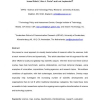Free Online Productivity Tools
i2Speak
i2Symbol
i2OCR
iTex2Img
iWeb2Print
iWeb2Shot
i2Type
iPdf2Split
iPdf2Merge
i2Bopomofo
i2Arabic
i2Style
i2Image
i2PDF
iLatex2Rtf
Sci2ools
JASIS
2010
2010
Science overlay maps: A new tool for research policy and library management
We present a novel approach to visually locate bodies of research within the sciences, both at each moment of time and dynamically. This article describes how this approach fits with other efforts to locally and globally map scientific outputs. We then show how these science overlay maps help benchmark, explore collaborations, and track temporal changes, using examples of universities, corporations, funding agencies, and research topics. We address conditions of application, with their advantages, downsides and limitations. Overlay maps especially help investigate the increasing number of scientific developments and organisations that do not fit within traditional disciplinary categories. We make these tools accessible to help researchers explore the ongoing socio-cognitive transformation of science and technology systems.
JASIS 2010 | Ongoing Socio-cognitive Transformation | Temporal Changes | Traditional Disciplinary Categories |
| Added | 28 Jan 2011 |
| Updated | 28 Jan 2011 |
| Type | Journal |
| Year | 2010 |
| Where | JASIS |
| Authors | Ismael Rafols, Alan L. Porter, Loet Leydesdorff |
Comments (0)

